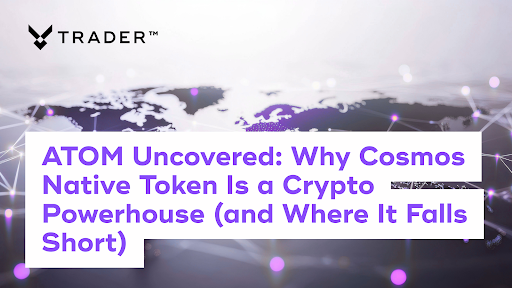ATOM Uncovered: Why Cosmos’ Native Token Is a Crypto Powerhouse (and Where It Falls Short)
You’re in the weeds, trying to figure out what’s worth your time in crypto. ATOM comes up a lot. It’s been around since 2019, tied to Cosmos—the network that said, screw silos, let’s make blockchains talk to each other. Not just bridge them. Actually connect them. Wild idea then. Still a big one now.
So what’s ATOM got going for it? What’s still shaky? Let’s get into it.
Cosmos Isn’t Just Another Chain
Cosmos doesn’t want to be the next Ethereum. It wants to be the framework other chains build on—and connect through. That’s where ATOM comes in. It powers the Cosmos Hub, which sits at the center of the network. It secures the chain, lets you vote on upgrades, and keeps the whole thing running.
But the real sauce? IBC. Inter-Blockchain Communication. It’s a native protocol that lets different blockchains send data and tokens between each other. No wrapped tokens. No middlemen. Just clean transfers.
It’s working. As of June 2025, there are over 100 IBC-enabled chains live, including Binance Chain and Osmosis. They’re doing millions in cross-chain volume daily (CoinGecko). It’s not some beta thing—it’s live. Devs are spinning up custom blockchains (called “zones”) with ease. One for gaming. One for DeFi. All talking to each other.
For you? That means staking rewards. Stake ATOM, secure the Hub, earn 15–20% APY (StakingRewards). Not bad, considering most banks are offering you table scraps.
And the fees? Barely there. Ethereum users were getting crushed by $50 swaps in 2021. Cosmos-based chains like Osmosis? You’re spending cents. That kind of speed and affordability doesn’t go unnoticed. It’s why builders have kept showing up.
Where Things Get Murky
Now for the flip side. ATOM’s not bulletproof. And Cosmos isn’t alone in this lane.
Polkadot has a similar idea, built around parachains. DOT is its token, and it’s still trading neck and neck with ATOM in market cap (CoinMarketCap). Meanwhile, Arbitrum’s scaling Ethereum. And Avalanche? Still making noise. Cosmos may be easier to build on, but “easy” doesn’t always win adoption wars.
Let’s talk staking risk. You can lose part of your stake if your validator screws up—goes offline, signs twice, whatever. It happened in 2023. People lost money. Trust got shaken (Cosmos Forum). There’s also the 21-day unstaking lock. In a fast-moving market, that can feel like a lifetime. Compare that to liquid staking on Ethereum—say, stETH from Lido—where you can get in and out without waiting.
Then there’s the Cosmos Hub problem. ATOM’s tied to it, but not every chain needs the Hub to thrive. Osmosis? It’s doing its own thing. If more zones go rogue or build outside the Hub’s orbit, ATOM’s value proposition weakens. You’ve seen this play out. $30 in 2022, down to $6 in 2023, now sitting near $10 (CoinGecko). Volatile isn’t the half of it.
Zoom Out: Why Cosmos Exists
Cosmos showed up when Ethereum was still choking on its own weight. Back in 2017, gas fees were absurd and scalability was a joke. Jae Kwon launched Cosmos with a new idea: Tendermint. Proof-of-stake, energy-efficient, and fast. It wasn’t trying to be a better Ethereum. It was trying to offer another path entirely.
Now, in 2025, Ethereum’s gone through The Merge. It’s greener. Layer-2s like Optimism have cut fees. Solana’s pushing transactions at insane speed. Cardano’s still slow but… thorough. Point is, everyone’s moving forward. Cosmos has to keep pace.
It’s trying. Gravity Bridge connects Cosmos to Ethereum. That means more liquidity and broader access (Cosmos Blog). Cosmoverse 2024 in Dubai showed off the ecosystem’s energy. New zones, new tools, open-source collaboration—it’s all happening. The SDK is still one of the easiest to build on, which helps. But people remember Terra’s 2022 collapse. It was built on Cosmos. That’s a stain, and stains don’t wash out easy.
What’s Coming—and What’s at Stake
So where does ATOM go from here?
Cross-chain everything is the trend—DeFi, NFTs, even identity systems. Cosmos is well-positioned, with 250,000 daily active users across its zones (DappRadar). Liquid staking is on the roadmap. IBC upgrades are coming. Governance changes are in the pipeline—all expected by September 2025 (Cosmos Roadmap).
But others are circling. Polkadot’s still in the fight. Chainlink’s pushing its CCIP protocol for cross-chain messaging. Even Binance is nudging into interoperability. If Cosmos Hub becomes less relevant, ATOM may end up being a passenger in the very ecosystem it helped build.
So here’s what you do.
If you’re investing? Don’t marry this thing. ATOM is a strong pick—but it’s not your whole portfolio. Pair it with DOT. Add some LINK. Maybe even keep an eye on Solana or NEAR. Spread it out. There’s no single winner here.
If you’re building? Cosmos is a solid place to be. Fast transactions, low fees, fewer guardrails. You get room to experiment without battling Ethereum’s congestion or Solana’s uptime issues.
Here’s the takeaway.
Cosmos built the rails for a multi-chain world before most people knew that’s what we’d need. ATOM is still a key part of that story. But nothing in crypto stands still. The tech’s good. The roadmap looks solid. But it’ll need momentum—and relevance—to keep ATOM from getting left behind.
Watch the upgrades. Pay attention to governance. Choose your validator wisely. And remember—this game moves fast.

Steve Gregory is a lawyer in the United States who specializes in licensing for cryptocurrency companies and products. Steve began his career as an attorney in 2015 but made the switch to working in cryptocurrency full time shortly after joining the original team at Gemini Trust Company, an early cryptocurrency exchange based in New York City. Steve then joined CEX.io and was able to launch their regulated US-based cryptocurrency. Steve then went on to become the CEO at currency.com when he ran for four years and was able to lead currency.com to being fully acquired in 2025.


